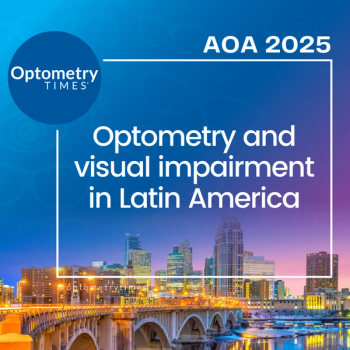
- May digital edition 2021
- Volume 13
- Issue 5
ODs can fill need for postconcussion vision rehab
Educate providers, build a referral network, and add tools of the trade
Since the early days of my graduate school training, it has been my dream to offer concussion and vision rehabilitation to patients. I credit this in large part to my wife, whom I met while she was training as a doctor of physical therapy.
Through her interest in brain injury and neurological rehabilitation, I was keen to learn more about the visual system and its impact on the efficacy of physical and occupational therapy outcomes.
Postconcussion syndrome and vision
More than half of the brain’s cortex is dedicated to visual processing.1 As the most common type of brain injury, concussions can be associated with visual symptoms such as blurry vision, difficulty reading, light sensitivity, double vision, and visual field defects. Patients can experience impaired eye tracking as one of the effects of postconcussion syndrome, occurring immediately after the initial trauma and sometimes lasting months or years.2
As I worked toward my optometry degree concurrent with a master of public health, I focused on the link between brain injuries and vision. I realized there was an unmet need for functional vision evaluation in patients with concussion, and I became passionate about filling that void.
I learned that only a handful of formally accredited physical medicine institutions had recommendations or resources related to vision. Although that tide is changing, vision concerns in the setting of concussion and brain injuries are still underdiagnosed and undertreated. This is largely because of the lack of understanding about treatment options and confusion around the appropriate specialist for referral. It is clear that ODs are specifically positioned to play a key role as a member of the interdisciplinary team alongside physical therapists (PTs) and occupational therapists (OTs) caring for patients with brain injury.
I have committed to educating health care providers about the advantages of referring patients to eye care specialists in order to identify and treat these often-overlooked concussion-related vision problems. ODs interested in adding or growing vision therapy as part of their practices will need to get to know their referral networks and understand the technology available to help patients achieve their personal recovery goals.
Educate
To build my patient base, I aimed to educate the largest source of referrals in my area about the benefits of vision therapy for patients with concussions. I worked to establish relationships with key providers such as PTs, OTs, speech therapists, and neuropsychologists at outpatient and inpatient rehabilitation facilities. I introduced myself to primary care physicians, as well as providers at urgent care centers and hospital emergency departments. I sought to help these health care providers understand that my practice is specifically positioned to treat eye movement disorders and that I was eager to collaborate with them to complement patients’ overall care.
Health care providers must understand that optimal benefits from physical and occupation therapy cannot be achieved if patients have underlying untreated deficits in their vision and/or eye movement. Sometimes the fix is an easy one, such as improving visual acuity with a change in a glasses or contact lens prescription or the addition of prism lenses. However, a detailed evaluation of a patient’s eye movements can identify disorders that will not show up on a standard eye exam.
Tests and tools of the trade
Succeeding at vision rehabilitation for concussion requires bringing something that is difficult to identify and hard to understand to the forefront for both referring providers and patients. One of the first things I invested in for my practice was technology to do just that.
Screening tests
My referral center will perform vestibular ocular motor screening on patients with concussion to learn whether moving the eyes or stimulating the vestibular system incites symptomatology. If so, the patient should receive an ocular, vision, and vestibular work-up. I recommend that our referring centers conduct a nearpoint of convergence test to measure the patient’s ability to bring the eyes together, which is often affected by concussions.
Diagnostic and treatment technologies
One of the cornerstone technologies I first implemented in my practice is the RightEye tracking system. This device uses infrared eye tracking technology to obtain an objective measurement of eye movements. RightEye provides information that cannot be gleaned from a standard eye examination and visual acuity testing. It allows me to quantitatively assess patients’ eye movements, pursuits, saccades, and fixation ability, and the reports can help track improvement over time.
In fact, RightEye has been invaluable for building my practice. Because it is portable, I can bring it into providers’ offices and show them how it works and the eye-tracking concerns it can uncover. My network has been impressed by the technology.
My practice has incorporated other diagnostic technology for use in patients with postconcussion syndrome, such as Computer Orthoptics VTS4 vision therapy system. Additional devices I use for therapy include the Sanet Vision Integrator, NeuroTracker, and Senaptec Sensory Station.
I also implement other tools such as vectograms, charts, Marsden balls, balance boards and beams, word and thought games, and parquetry blocks. Vision therapy requires discovering the patient’s status and goals and tailoring the approach. It is not a one-size-fits-all treatment.
Conclusion
Vision therapy remains an underexplored area for ODs, and a lack of insurance coverage and the cost of devices are barriers to entry. However, a rewarding opportunity exists for those who commit to educating their referral networks to build a patient base. Brain injuries affect nearly 1.7 million Americans every year.3 Providing postconcussion vision care to these patients helps them to enjoy an improved quality of life.
References
1. Hagen S. The mind’s eye. Rochester Review. 2012;72(4). Accessed April 14, 2021. http://www.rochester.edu/pr/Review/ V74N4/0402_brainscience.html
2. American Psychiatric Association. Diagnostic and Statistical Manual of Mental Disorders, 4th Edition. American Psychiatric Association; 1994.
3. Traumatic brain injury in the United States. Centers for Disease Control and Prevention. March 2010. Accessed April 14, 2021. www.cdc.gov/traumaticbraininjury/pdf/blue_book.pdf
Articles in this issue
over 4 years ago
What to look for in a telehealth vendorover 4 years ago
Your future telehealth programover 4 years ago
The safest way to fire a staff memberover 4 years ago
Tips for preventing ocular zoom fatigueover 4 years ago
Embrace, don’t fear, AI in diabetic retinopathyover 4 years ago
Using surveys to help manage dry eye diseaseover 4 years ago
From pipeline to prescription: New drug approval processover 4 years ago
OCT in glaucoma management: Green isn’t always cleanNewsletter
Want more insights like this? Subscribe to Optometry Times and get clinical pearls and practice tips delivered straight to your inbox.















































.png)


